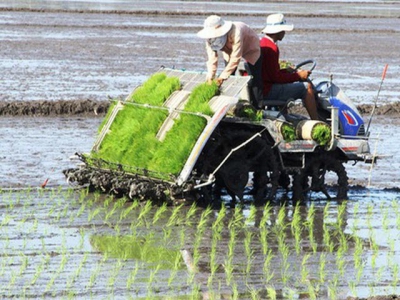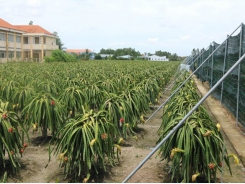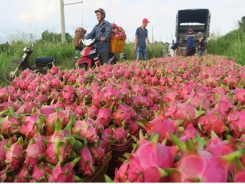Positive signals from agricultural sector

The Covid-19 pandemic is developing complicatedly globally, but agricultural exports of Vietnam in the first six months of this year still exceed the set plan.
Smart rice cultivation model of Mekong Delta farmers. (Photo: SGGP)
Experts said that the shift of thinking from agricultural production to agricultural economy, the promotion of the application of high technology, and the improvement of product quality have helped many agricultural products of Vietnam to gain a foothold in the international market.
Passport for export of agricultural products
Vo Van Trung in Binh Thanh Commune in Phung Hiep District of Hau Giang Province was one of the first farmers to grow melons when there was a policy of the agricultural sector. With 3,000 square meters of land, thanks to high-tech melon cultivation, he has earned an income of over VND500 million per year in the past five years. From the effectiveness of his melon production model, a dozen local farmers participated in establishing Thuan Phat Melon Cooperative, with an area of 9,000 square meters, earning VND2 billion per year.
“Up to now, Hau Giang Province has more than 30 greenhouses and 50 net houses for growing melons and clean vegetables to supply the markets everywhere. This is a pioneering model in applying drip irrigation technology and controlling irrigation and fertilizer regimes through smart devices," said Mr. Tran Chi Hung, Director of the Department of Agriculture and Rural Development of Hau Giang Province.
Many institutes and universities locate in Can Tho City, so high-tech agricultural production develops quite quickly. Up to now, Can Tho has built six concentrated production areas for key products in the value chain, such as large-scale high-quality rice-growing areas with an area of 214,000 hectares and the growing areas for vegetables and short-term industrial crops with an area of nearly 18,000 hectares. At the same time, the city has implemented policies to support the development of high-tech agriculture, with a total budget of more than VND231 billion. Along with that, it has built 41 supply chains of safe food for 239 agro-forestry-fishery products and supported the application of smart stamps and traceability.
In Bac Lieu Province, by mid-2021, 23 companies and over 650 households have invested in super-intensive white-leg shrimp farming, with advanced technology bringing high efficiency. Currently, in Bac Lieu Province, four enterprises have been granted certificates of high-tech agriculture, and seven facilities have been certified for meeting international standards in clean shrimp farming. According to the assessment of the Ministry of Agriculture and Rural Development (MARD), high-tech shrimp farming can control the farming environment, water sources, diseases, and food safety, reduce risks, and provide clean raw materials, with traceability from shrimp breeding stock and feed. This is a sustainable direction.
Need timely policy
In May 2017, the Prime Minister issued a decision to establish a high-tech agricultural area to develop shrimp farming in Bac Lieu Province. The province highly expects that this high-tech zone will turn Bac Lieu into the center of the shrimp industry of Vietnam. Mr. Pham Hoang Minh, Director of the Management Board of the Bac Lieu High-tech Agricultural Development Zone, said that after being deployed, up to now, Phase 1 has been completed, and nine enterprises have been selected to invest in this zone to develop shrimp varieties, probiotics, and shrimp feed. According to Mr. Minh, the main goal of this zone is to build effective high-tech shrimp farming models and meet export demand well, then spread them to the whole province and the whole country.
Bac Lieu Provincial People's Committee has recently issued a plan to restructure the province's agricultural sector in the 2021-2025 period, in the direction of high-tech application. Bac Lieu promotes the project to make the province become the center of the industrial shrimp industry in Vietnam and prioritizes the development of super-intensive, intensive, and semi-intensive shrimp farming. According to Mr. Pham Van Thieu, Chairman of Bac Lieu Provincial People's Committee, the province will create favorable conditions to attract enterprises to invest more in the high-tech agricultural zone to develop the shrimp industry; create a favorable environment for enterprises to link production in the value chains with farmers; recommends the replication of the model of clean shrimp production and consumption in a closed chain of Viet Uc Group.
It can be said that the application of high technologies in agricultural production is an inevitable trend, and the rice industry has made remarkable progress. According to Assoc. Prof.-Dr. Duong Van Chin, former Deputy Director of the Mekong Delta Rice Research Institute, the recent highlight of Vietnam's rice industry is technology application and selective breeding of many high-quality and delicious rice varieties with high selling prices in the global market. Their prices are higher than Thai and Indian rice in the same segment. Rice varieties, like ST24, ST25, and Loc Troi 28, can build brand names for the premium white fragrant rice segment in the near future.
Mr. Tran Chi Hung, Director of the Department of Agriculture and Rural Development of Hau Giang Province, acknowledged that in the past time, the development of high-tech agriculture has been directed by the MARD. However, the support for high-tech models is mainly through agricultural extension policies, and there is no specific policy. Meanwhile, these models require a relatively high initial investment cost, only suitable for organizations and individuals with strong financial resources. Hence, the expansion of high-tech agriculture remains sluggish.
Many departments of Agriculture and Rural Development of Mekong Delta provinces also said that the investment cost of high-tech agricultural models is extremely huge. Many facilities do not have enough capital to improve production processes and product quality. To solve this problem, the MARD recommends promoting digital transformation in agriculture. The ministry will provide specific guidelines and action plans and propose to the Government to issue new policies to help the digital transformation in the agricultural sector to be effective.
In the first six months of this year, the total export turnover of agro-forestry-fishery products reached US$24.23 billion, up 28.2 percent year-on-year. According to the MARD, in the second half of this year, the industry will strive to realize the dual goal of ensuring pandemic prevention and control and achieving an export turnover of $45 billion. Therefore, it is necessary to implement solutions that affect key export products and increase export value to compensate for those, which are expected to fail to achieve the target.
Có thể bạn quan tâm
Phần mềm

Phối trộn thức ăn chăn nuôi

Pha dung dịch thủy canh

Định mức cho tôm ăn

Phối trộn phân bón NPK

Xác định tỷ lệ tôm sống

Chuyển đổi đơn vị phân bón

Xác định công suất sục khí

Chuyển đổi đơn vị tôm

Tính diện tích nhà kính

Tính thể tích ao hồ



 Đồng Tháp launches agricultural products website
Đồng Tháp launches agricultural products website  Farm produce exports - specialties reach new markets
Farm produce exports - specialties reach new markets